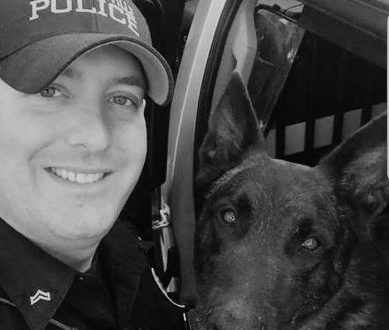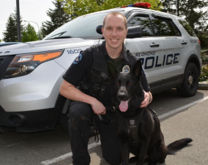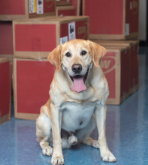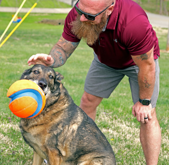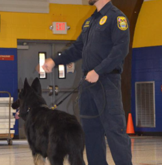Died – 6/5/18
Handler – Cpl/ Rick Ashabranner
Two local police K-9s remembered for service
Within the past week, the Jeffersonville Police Department and the Clark County Sheriff’s Office have faced the death of dogs that had served in their K-9 units. These K-9s helped officers find narcotics, perform searches and apprehend suspects. Yet they were more than just police dogs. For the handlers who served with them, they were like family. Cpl. Rick Ashabranner worked alongside a Dutch shepherd named Ares for about 11 years with Jeffersonville police before the dog’s retirement last year. On Tuesday, the dog was euthanized after struggling with multiple health issues. When Ashabranner first started working with Ares, both he and the dog were new to police work. He had only worked as a policeman in the JPD for a little over a year before he started training with Ares, who was a 5-month-old puppy at the time. They both worked and learned together, Ashabranner said. Ares eventually grew into a 100-pound dog and received the nickname “Marmaduke.” The first years were clumsy — Ares was like “Bambi on ice,” he said, and both of them fell down frequently as they learned to work together. “There were a lot of ups and lot of downs,” he said. “There was a lot of getting to know the ways to do it, and picking ourselves up off the ground, figuratively and literally.” The handler and K-9 soon became in sync as they worked as a team. The last six years with Ares were like being on cruise control, Ashabranner said. Ares was a playful dog, Ashabranner said, and although he was down for business, he was less enthusiastic about certain tasks he was commanded to perform, like article search or evidence recovery. However, he loved tracking areas or buildings and physically engaging suspects. Throughout his 11 years of working long hours with Ares, Ashabranner developed a strong connection with the K-9. He felt a sense of calm having him in the back of his car every time he went to work. He knew that the dog would always have his back. For Ashabranner, Ares was like a member of his family. But the relationship between a police dog and its handler is more complicated than that. It is important to always be aware that the dogs are also tools in their police work, Ashabranner said.“You can’t let the fact that he feels like family override the fact that if I need him to go out in a blaze of glory for something really bad that’s happening, he needs to go out in a blaze of glory to save a life of a citizen or to save the life of a fellow officer or to save my own life,” he said. “You have to hold that distinction.” For Lt. Glenn Jackson, who is JPD’s K-9 commander and trainer, the difference between a police dog and a pet is simple. When they put the dogs in dangerous situations, it is easier if they are not perceived as pets. “At what point do you ask your pet to put it’s life on the line?” he said. “At what point are you putting your life on the line through this dog —and/or the life of someone else? There’s the true difference. I know it hurts for an everyday citizen to put their pet down, but try putting your partner down. There’s a difference between a pet and a partner.” Ares retired from K-9 service last May, and Ashabranner started working with another Dutch shepherd called Vali soon after. It’s been an adjustment to serve with a new dog, he said, especially after working with Ares for so many years. The death of Ares has been painful for Ashabranner. He took a few days off work after he was euthanized, and he decided to take down the dog’s kennel. “Simple little things like backing out of my driveway and seeing his kennel for the past couple days kind of sucked, so that’s why I took them down,” he said. The Clark County Sheriff’s Office also experienced a recent loss of one of their K-9s: a Czech shepherd named Samurai. The K-9, who was euthanized June 2 after a battle with pancreatitis, served in the department for more than two years. During that time, Samurai served alongside his handler, officer Dan Doty, who developed a strong connection with the dog, whom he often called “Sammy.” Samurai was a friendly, happy-go-lucky dog who was always excited to go to work, Doty said. As soon as he put on his police uniform or started the car, the K-9 would immediately perk up. “If you could transition a human expression to his face, he would be smiling,” he said. For Doty, finding Samurai was a stroke of luck. He first met Samurai at an International Police Working Dog Association event in Tennessee. The dog was originally from the Czech Republic, but he was brought to the Sevier County Sheriff’s Office in Tennessee to serve as a K-9. His previous handler left the department, so the dog did not have a partner at the time. When Doty met the dog, they immediately started to bond, so he brought the K-9 to Clark County. As he started working with Samurai, Doty had to learn to use Czech phrases for commands. He spoke an Eastern Kentucky type of Czech, he said. Although Samurai was a working dog rather than a pet, he felt like part of the family, Doty said. It was like they could read each others demeanors and facial expressions. “He was a great blessing,” Doty said. “He was really a fantastic dog.” Samurai was only 5 years old when he was put down. He was suffering heavily from pancreatitis, and although he did everything he could to help the dog, it soon became clear to Doty that he was not going to recover. “He had a strong mind and a strong heart, but his body was going,” he said. Life feels much different without Samurai, Doty said. His house feels empty, and he misses the dog’s presence in the back of his patrol car. “It’s a huge void for me since he’s not there,” he said.
